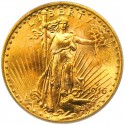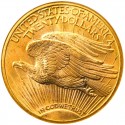- United States Coins
- Saint-Gaudens Double Eagles
- 1916 Saint-Gaudens Double Eagle
1916 Saint-Gaudens Double Eagle
Coin Info
The 1916 Saint-Gaudens double eagle is named after its designer, Augustus Saint-Gaudens, a famed sculptor who was commissioned by President Theodore Roosevelt to redesign the $20 gold coin. Double eagles are widely collected by numismatists and popular among investors as they contain nearly one full troy ounce of gold and feature a beloved, very patriotic design.
Only San Francisco produced double eagles in 1916, and no proof coins double eagles were made that year. 796,000 pieces were originally struck and pieces in Extremely Fine-40 are worth about $3,752 .
Below are specifics about the Saint-Gaudens double eagle:
-
Face Value: $20
-
Overall Mass: 33.436 grams
-
Diameter: 34 millimeters
-
Edge: Lettered, “E PLURIBUS UNUM”
-
Composition: 90% gold, 10% copper
-
Gold: .96750 troy ounces
Production of the Saint-Gaudens double eagle, which had already been cut back severely in 1916, would go on full hiatus through World War I. Striking of the Saint-Gaudens double eagle would resume in 1920, when the coin would gain favor among international investors and would often serve a role in international trade, when the coin would be viewed globally as a stable form of currency amid troubling times on the world scene.
1916 Saint-Gaudens Double Eagles for Sale
Other Years From This Coin Series:
-
{{#owner}}
-
{{#url}}
{{#avatarSrc}}
{{name}} {{/url}} {{^url}} {{#avatar}} {{& avatar}} {{/avatar}} {{name}} {{/url}} - {{/owner}} {{#created}}
- {{created}} {{/created}}


